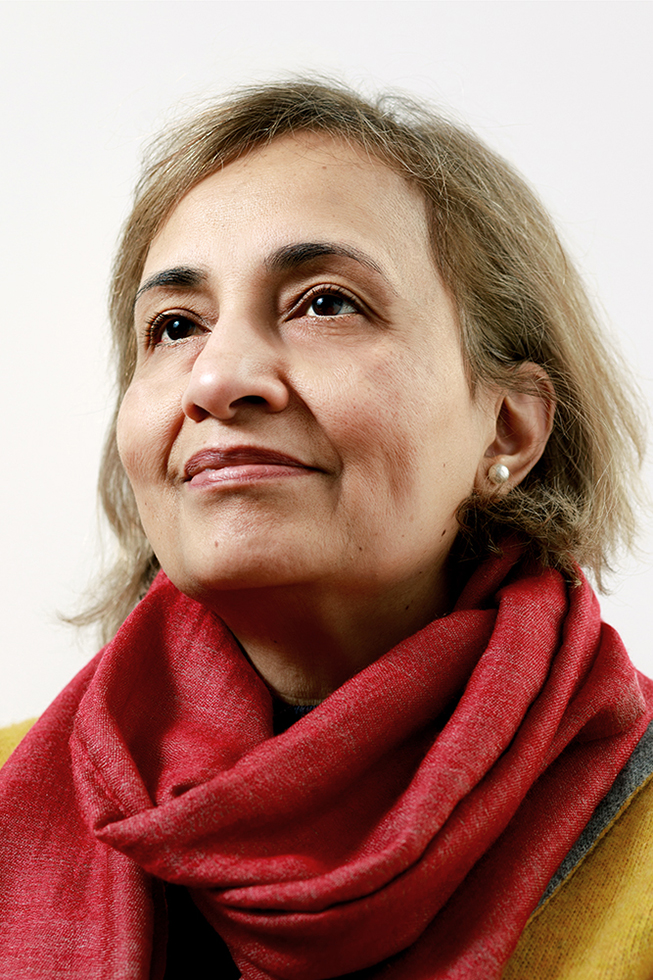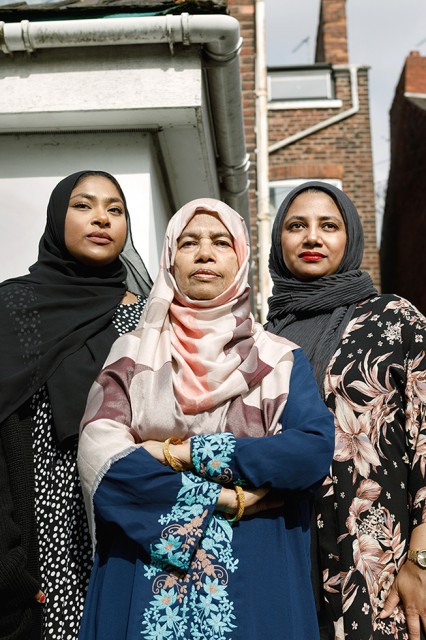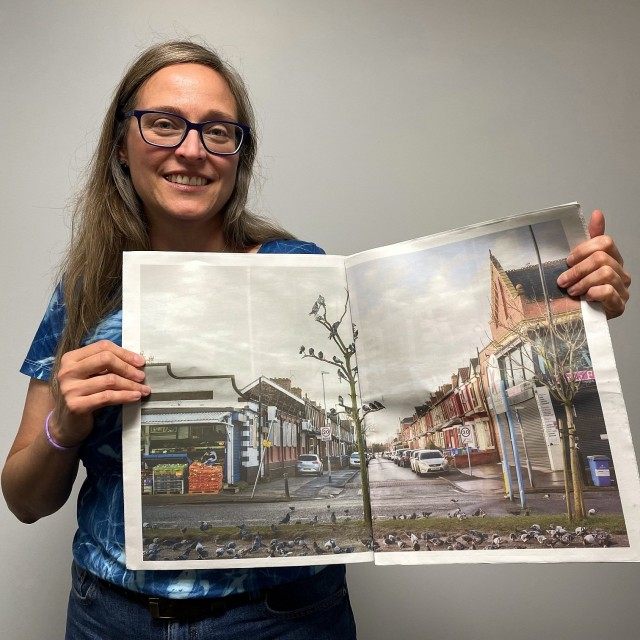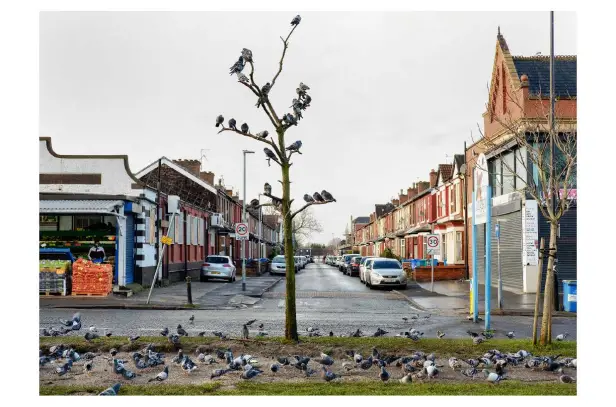The Big Interview: Portrait of Britain Winner Roxana Allison

Winning this year’s Portrait of Britain award for her images of Manchester’s community superheroes, photographer Roxana Allison tells us what she’s learned about trust, ethics, and what, of course, makes an award-winning portrait…
Photographer Roxana Allison grew up in Mexico City and is now based in Longsight, Manchester, UK. She has today been announced as one of 100 winners of the British Journal of Photography’s Portrait of Britain award, ‘an ode to the strength and unity that define the people of the United Kingdom.’ Her two winning images of the women who work hard to make her neighbourhood a better place – Nadia Siddiqui (above) from Women’s Voices, and Nasima Begum, Shireen Sobhani and Safina Islam (below) from the Manchester Bangladeshi Women’s Organisation (Ananna) – will be exhibited on JCDecaux screens across the country from January to February 2024, and featured in the Portrait of Britain Vol. 6 photobook by Bluecoat Press.
Part of her photographic series Hope. Despair. Miracles., these award-winning portraits recognise the unseen, community-driven, positive projects happening across Longsight, beyond the stereotypes and negative press the area has long been subject to; acting, Allison notes, as ‘a commentary on socio-economic inequality in today’s Britain and the resilience of its multi-ethnic communities.’ Her upcoming solo exhibition of the same title opens at Waterside Gallery, Trafford, at the end of this month.
Socially-driven, Allison’s projects include Operation Jurassic, a collaboration with her brother, Pablo, who was imprisoned as part of the UK’s largest anti-graffiti investigations, and which recorded their experience of the criminal justice system.
A 2023 Trace Mentorship Programme alumnus, Allison has previously collaborated with Impressions Gallery, Open Eye Gallery, The University of Bolton, Manchester Art Gallery, HOME, Manchester Metropolitan University, and The Travelling Heritage Bureau, amongst others.
Laura Robertson: Congratulations Roxana, what fantastic news. Can you tell me, what makes an award-winning portrait?
Roxana Allison: I was thinking a lot about that question. How to answer it? I translate this as maybe ‘what makes a good portrait?’ A good portrait is one that sticks in your mind: you want to see it over and over again. It also evokes emotions that other portraits have never evoked, or don’t have the capacity to evoke in you. When I see these two portraits that were, first of all, shortlisted, and now have won Portrait of Britain, I have a feeling of awe – I could not believe that I had taken them.
A feeling of awe, like an out-of-body experience?
Like, did I actually make these images? It was a difficult photography session for me to do, and I just thought, I’m going to waste this opportunity and I’m not going to be able to produce something I’m happy with. I was unsure and didn’t feel entirely clear about how things were going on the day. I asked Nasima, Shireen and Safina (below) to arrange themselves in a way they felt comfortable. And then for it came together, almost unexpectedly… I prepare a lot for the portraits, but sometimes you just can’t predict what’s going to happen. I didn’t know 100% if they were award-winning portraits, but I knew they were good!

You have come up with a list, there, of what goes into a good portrait. Preparation, of course, and research, but also intuition. What would you add to that?
Collaboration. For me, it’s really important to have people feel at ease. Every photographer is going to say that, probably, but It’s important for the people that I work with to feel that I’m not just there to take their picture, or then not even ask them if they’re happy with it. Along the whole process, I’m very mindful of, firstly, the language I use, secondly, my role, and that they understand what this photograph can do after I’ve taken it, and where it will go. It’s important that I’m clear. Nadia, Nasima, Shireen and Safina were very clear, as well, with what they expected from me. I felt very privileged to be able to walk into their space and I was very careful with how we worked, to listen. And if they weren’t happy with anything, they could change the terms whenever they wanted.
It sounds like you’ve added clarity to the list – clear expectations from both sides.
Yeah, because these two final images are also part of a body of work, Hope. Despair. Miracles., not portraits on their own. I’m thinking about composition, and how they would work with the other portraits, what messages would I like to send to the viewer? I wanted to show how strong and resilient these women are.
I think their resilience and grace comes across immediately.
The mix of generations, one from each, reflects the wide span of their work with Ananna, the Manchester Bangladeshi Women’s Organisation [who provide meaningful activities, support, information and signposting, particularly for disadvantaged women that are survivors of domestic abuse or have struggled with mental health] and Women’s Voices [who provide training and activities for women seeking asylum, refugees, and other vulnerable women from diverse backgrounds], across 30 years. They’ve been working in the same location and with the same aims in very difficult circumstances.
What did Nadia, Nasima, Shireen and Safina want out of the portraits? What did they say to you?
What they didn’t want is easier to explain. Because of the nature of their work, they didn’t want me to misuse the images or sell them for commercial gain that had nothing to do with the work I’m doing, or in a way that could shine a negative light on their work, because they’ve experienced this type of interaction before, and as a result, are rightly distrustful of photographers. I had to be very mindful of that.

Because you’re a photographer working in your own community, did that go some way to build an initial trust?
I think it did. The way I approached people relied on introductions and endorsements. It took me many, many attempts and many, many different people to get in touch with a lot of the Longsight organisations featured in Hope. Despair. Miracles. I was very conscious of my limitations, I guess, also my skin colour, and the entitlement that comes with being perceived as white. I was asking myself many questions throughout the whole process and learning a lot as well and letting go.
How did those initial conversations start?
I always started the conversation in person and quite informally, just to tell them who I was, where the project was coming from, that I am mixed race, and that my projects tend to be very influenced by my dual nationality, and my roots here and in Mexico. That’s when people really could relate to me. A lot of the people I photographed for this series are either first generation migrants or the children of migrants. There were more things in common than we thought.
That desire to establish trust comes with the desire to establish a commonality and an immediate connection. I think that speaks to how considerate your work is. Nothing’s gimmicky or reactive, it’s very carefully thought out and sensitive.
And, yeah, I was also careful because everyone knows where I live! [both laugh]
I know that one of the key things that you wanted to address in the project Hope. Despair. Miracles. was the reputation of Longsight being considered officially a ‘deprived’ area of Manchester, and trying to dissolve these stereotypes through the lens of your Mexican upbringing.
I realised if you take deeper look beyond the surface layer, there’s so much hope there, but you can’t see it straight away. In Longsight, I was reaching a point of complete despair with the rubbish – so I started litter picking! It sounds really mundane.
But litter can represent a lack of services, a sense of hopelessness, and make you question why it’s happening, and all the complex reasons behind it.
Yes, I think that was the first sign, litter, one thing that was having such a negative impact on my mental health. At least I felt like I could do something about it. Me and my neighbour were sick and tired of seeing all this rubbish piling up in the back of our alleyway, to the point it was even difficult to get our bins out. Like it was very unfair, as well. I just thought, let’s do something, if it works, it works, if it doesn’t work, then we just carry on and try something else. And it worked overnight! The alleyway was turned into a garden. It made me think, surely, we’re not the only two people that are making this place better for everyone. And that’s when hope started to feel tangible.

And you subsequently used photography to make your neighbours, real change-makers, visible; hard work that usually goes on unrecognised, or behind closed doors, you’ve brought out to the fore and celebrated its impact.
Hope through action is what makes it real hope, as this abstract concept of ‘hope’ without action does nothing for you. It only gives you the longing, like it’s one day going to happen, but you never see the results. But when you see hope through action and it’s not only yourself, but it’s also other people, then everything starts changing. My whole perception of Longsight has changed. I was one of those people who focused only on Longsight’s negative aspects. I didn’t want to live here anymore because there were so many problems. But then, when you realise that other people are doing things, and word of mouth starts to travel, then you go oh, right, I’ve been unfair.
When Covid came along, this was very important, because even though it was a horrible time of our lives, it gave me time to go round my streets with few people or distractions, and to observe as a photographer all these different elements that make up the whole of where you live. I realised that I live in a version of Mexico: it’s not exactly there, but some of the problems are. What was I understanding as a ‘first world’ country? I used to think that everyone in Britain was educated, everyone has money, is respectful, and there are so many opportunities. Then I realised no, there’s many different worlds in this one country, just as there are many sides of Mexico. I questioned the stereotypes and also Britain’s colonialist past.
How did photographing local groups – across arts, sports, gardening, cooking, social care, play – make you reconsider your definition of ‘community’?
Authority plays a big part in how this community struggles. They’re trying to do what the government isn’t doing for them. My community would not have to necessarily do what they do if those problems didn’t exist here, or the government was doing their job properly.
I came to an understanding that the ways people deal with the issues as a community are similar to how they’re dealt with in Mexico. Society is less tied to meticulous planning of the future and more spontaneous, also very collectively minded, where people are very sociable and perceive themselves as part of a whole, and get together to resolve a certain issue instead of following and relying on official mechanisms.
That’s why the series works, because it’s unapologetically, recognisably Longsight. You’re not sugar coating anything, the issues and problems are there, parallelled with people active in doing something about it. In what ways have these portraits impacted your ethical approach as a photographer?
I really wanted to represent the main population and the rich diversity of Longsight as active change-makers in our working-class communities, and include Urdu speakers, the main language that is spoken on these streets and this is why it was important to have the project’s newsprint in English as well as in Urdu, to be able to reach very directly relevant audiences as well as wider ones beyond the locality. There was a lot of dialogue, being very clear about my aims. Also, asking myself questions: Was I doing the right thing? Was I keeping very true to what I wanted to portray? I actually asked those featured what they would think if I won a competition with the images…
Wow, you manifested the win! [both laugh]
I asked them, if your face was all over the place, on billboards, across the whole country or maybe internationally, how would you feel? Now that they know the portraits have won, they’re so happy, because it’s more recognition for what they do, and to shine a bright light on Longsight for all the good reasons. They feel noticed, even though they’re not driven by recognition to do what they do. I don’t want to let down people who are important to me.
Laura Robertson
Images from top: Roxana Allison’s two winning portraits, for Portrait of Britain Vol. 6, from the series Hope. Despair. Miracles. (2019 – 2023); Nadia Siddiqui from Women’s Voices, and (L-R) Nasima Begum, Shireen Sobhani and Safina Islam from the Manchester Bangladeshi Women’s Organisation (Ananna). The photographer with her newsprint, Hope. Despair. Miracles. (2023). Longsight, Manchester, courtesy Roxana Allison
Portrait of Britain Vol. 6 will exhibit on JCDecaux UK screens across the country from January to February 2024
The Portrait of Britain Vol. 6 photobook, published for the first time in collaboration with Bluecoat Press and sponsored by JCDecaux, is now available for pre-order with a 20% discount on the Bluecoat Press website
See Roxana Allison’s solo exhibition, Hope. Despair. Miracles., at Waterside, 1 Waterside Plaza, Sale, Trafford, M33 7ZF, from 27 January until 31 March 2024 – FREE entry
Buy a Hope. Despair. Miracles. Special Edition parcel directly from her website: a full colour 64-page signed newsprint, including the award-winning portraits, plus a signed 5×7” print, enamel pin of the word ‘Miracles’ in Urdu language handcrafted in Mexico, and a souvenir from Longsight





